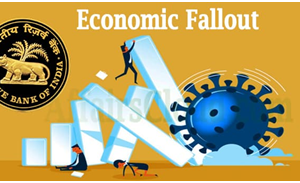Recent Economic Trends RBI increase repo rate 35 bps India (RBI) raised the policy repo rate by 35 basis points (bps) to 6.25%, downshifting gears from consecutive increases of 50 bps, and scaled down GDP growth hopes for the year to 6.8% from 7%. A 100 basis points equals one percentage point. The central bank retained its inflation projection for 2022-23 at 6.7%, noting that inflation will ease but stay well above the 6% upper tolerance limit set for the RBI. Reports and Indices Global Wage Report 2022-23 Report, by International Labour Organisation (ILO), presents an analysis of how concurrent crises - COVID-19 pandemic followed by cost-of-living crisis - have impacted wages and purchasing power across countries and regions. Key highlights of the Report Rising inflation is causing real wage growth to dip into negative figures in many countries thereby reducing purchasing power. On average, Wage employees lost six weeks of wages due to COVID-19 crisis. Low wage earners, workers in the informal economy and women wage earners group suffered most. India Inequality Report 2022 : Digital Divide released by OXFAM India It is an annual report to highlight ongoing inequality crises in the country. The 2022 report highlights the extent of digital divide in India and its impact on essential services such as education, health and financial inclusion. Oxfam India is a non-profit organization working to support child education, empowering women & fighting against inequality in India. Key highlights of report 61% of men owned mobile phones in 2021, compared to just 31% women. Only 31% of the rural population uses the Internet compared to 67% of their urban counterparts. Use of computer devices has decreased (post-COVID) in rural areas. Likelihood of a digital payment by the richest 60% is four times more than the poorest 40% individuals, households, businesses…
Recent Economic Trends
RBI most popular among central banks
The Reserve Bank of India is not the most powerful in terms of monetary fire power like its peers in the US and Europe but when it comes to popularity, the monetary authority is the most followed on Twitter. With the microblogging site emerging as a key platform for information dissemination, many central banks are active on Twitter, especially in these times of economic uncertainties amid the coronavirus pandemic. The 85-year-old RBI and its Governor Shaktikanta Das have separate Twitter accounts. RBI's Twitter handle has 7.45 lakh followers. On April 20 alone, the handle saw 1.31 lakh new followers, according to an official with the central bank, who attributes the massive spike to an ongoing campaign. Since March 2019, the count of followers has more than doubled from just about 3,42,000 to over 7,50,000 to data Closely behind RBI is the Bank Indonesia, the central bank of the East Asian nation, with 7.15 lakh followers. At the third spot is Banco de Mexico - the apex bank of Mexico - with 7.11 lakh followers on the microblogging site.
Transcorp becomes the 1st non-bank company to receive RBI nod to enter into co-branding arrangements

The Leading forex and payment solutions provider Transcorp International Ltd (TIL) becomes the 1st non-bank company to receive Reserve Bank of India(RBI) nodto enter into co-branding arrangements for prepaid Instruments. It has also launched its multi-wallet RuPay-powered prepaid cardswhich allow corporate houses to pay wages, incentives, reimbursements & recurring payments to their employees or beneficiaries As part of the government’s initiatives of cashless India, it has also launched its multi-wallet RuPay-powered prepaid cardswhich allow corporate houses to pay wages, incentives, reimbursements & recurring payments to their employees or beneficiaries. It is the 1stnon-bank player in India to issue National Common Mobility Cards (NCMC/One Nation One Card) by National Payments Corporation of India (NPCI) certification to be used in Transit Systems and Smart Cities.
RBI announces fresh relief measures to tackle economic crisis
Reserve Bank of India (RBI) Governor Shaktikanta Das on Friday announced much-needed relief for small and medium-sized financial organisations including NBFCs and MFIs, which have been struggling to operate in the wake of the Covid-19 pandemic. The announcement comes after reports that the government was planning to release another stimulus package to support such smaller businesses, which often borrow from NBFCs and MFIs. It has been decided to provide special refinance facilities for an amount of Rs 50,000 crores to National Bank for Agriculture and Rural Development (NABARD), Small Industries Development Bank of India (SIDBI), and National Housing Bank (NHB) to enable them to meet sectoral credit needs To empower states for adequate borrowing, the RBI has also increased WMA limits by 60 per cent, to plan their market borrowings better. This facility will be available till September 30. The RBI has also asked all banks to not make any dividend payments to shareholders due to the ongoing financial challenges. The Reserve Bank has brought down the LCR (Liquidity Coverage Ratio) requirement of banks to 80% from 100%, giving more liquidity to banks. Earlier, last month, the RBI cut the repo rate by a massive 75 basis points, while Finance Minister Nirmala Sitharaman had announced a mega economic relief package worth about Rs 1.7 lakh crore.
RBI to launch Sovereign Gold Bonds Scheme 2020-21 in H1 FY21 on behalf of GoI

The Central government after exercising its power conferred under clause (iii) of section 3 of Government securities Act 2006has launched a new series of the Sovereign Gold Bond (SGB) Scheme namely “Sovereign Gold Bond 2020-21” which is to be issued by Reserve Bank of India (RBI) in six tranches from April 2020 to September 2020 i.e. in first half of FY 20-21. Their sale will be restricted to resident individuals, HUFs, Trusts, Universities and Charitable Institutions. These bonds will fetch a fixed interest rate of 50% per annum which will be taxable under Income Tax Act, 1961. On the other hand, capital gains tax arising on redemption of SGB to an individual has been exempted.
Nirmala Sitharaman, RBI Governor to meet G-20 finance ministers next week
Finance Minister Nirmala Sitharaman and RBI Governor Shaktikanta Das will on April 15 participate in the meeting of the G-20 countries to discuss the way forward in supporting the economy after the COVID-19 pandemic. The virtual meeting of the finance ministers and central bank governors comes within a fortnight of their last meeting on March 31.
RBI announced additional measures to tackle the economic fallout of COVID-19

The Reserve Bank of India (RBI) has announced additional measures namely- relax the export norms, increase in Ways & Means (WMA) limit & implement the counter cyclical capital buffer (CCyB) to tackle the economic fallout due to COVID-19. Brief about the measures An extension of the realisation period of export proceeds RBI has extended the period of realization & repatriation of export proceeds for exports made upto or on July 31, 2020 has been extended to 15 months What is CCyB? Its main objective is to use capital buffers to achieve the broader macro prudential goal of protecting the banking sector, which is often associated with creating system-wide risk from periods of excessive credit growth.
Merger of 10 state-run banks into 4 to come into force from April 1: RBI
The mega bank consolidation plan is all set to come into force from April 1, 2020. The branches of merging banks will operate as of the banks in which these have been amalgamated. Also, the customers of merging banks will be treated as customers of the banks in which these banks have been merged with effect from April 1, 2020. The government on March 4 had notified the amalgamation schemes for 10 state owned banks into four as part of its consolidation plan to create bigger size stronger banks in the public sector. As per the scheme, Oriental Bank of Commerce and United Bank of India will be merged into Punjab National Bank; Syndicate Bank into Canara Bank; Allahabad Bank into Indian Bank; and Andhra Bank and Corporation Bank into Union Bank of India.
RBI announces draft revival plan for Yes Bank

The Reserve Bank of India (RBI) placed in public domain a draft scheme for reconstruction of Yes Bank. State Bank of India has expressed its willingness to make investment in Yes Bank and participate in its reconstruction scheme. SBI can invest for up to 49 per cent stake for nearly Rs 2,450 crore. The central bank had invited suggestions and comments from members of public, including the banks' shareholders, depositors and creditors on the draft scheme. Suggestions will be received by RBI till Monday, March 9, 2020, after which a final call will be taken.
RBI introduced 12 indicators for calculating India’s growth: RBI Working Paper
Reserve Bank of India (RBI) has come up with a new method of calculating India’s growth through a Working Paper titled “Nowcasting Indian GDP growth using a Dynamic Factor Model” under the RBI Working Paper Series, introduced in March 2011. Here are the 12 indicators: Index of industrial production (IIP) –consumer goods IIP- core sectors Automobile sales Non-oil non-gold imports Exports Rail freight Air cargo Foreign tourist inflows Government tax receipts Nominal Effective Exchange Rate (NEER) Sensex Bank Credit

